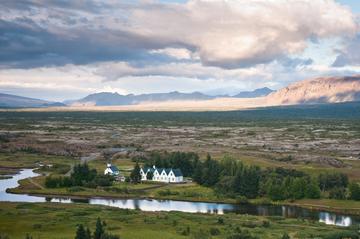Thingvellir National Park
TIME : 2016/2/22 11:28:55

Thingvellir National Park
This rocky, hilly volcanic landscape in the southwestern countryside was made Iceland’s first national park in 1928, and a UNESCO site in 2004. A deeply significant cultural site for Iceland, this is where Althing, a historic open-air assembly of Icelandic representatives, was held from 930 to 1798. Ruins remain of 50 rock-hewn attendee booths, symbols of a medieval-era Norse political practice that persisted here well into the 18th century.
Althing was Iceland’s initial version of Parliament, and reflected the governmental style of Iceland’s early Norwegian settlers. In the ancient Norse culture, individual chieftains ruled disparate geographical areas but worked collaboratively with other chieftains to create a balance of power; this collaboration required annual face-to-face gatherings of chieftains and their extended clans. These gatherings would last two weeks or more, accompanied by temporary dwellings and markets, as well as entertainment like storytelling, feasts and sports tournaments.
By the year 930, the public land of the Thingvellir region had been chosen for this purpose, as it was deemed accessible from much of the country, which is full of (then-insurmountable) obstacles like huge mountains, glaciers and wide rivers. While communal gatherings here ultimately strengthened the Icelandic culture, the power of the Althing system eroded over time, proving ineffective at keeping more influential chieftains in check. The country was folded into the kingdom of Denmark in the late 1300s, kicking off a long period of decline that included the Black Plague and other deadly diseases; Danish imposition of the Reformation and later, a crippling trade monopoly; and many violent volcanic eruptions.
Though it evolved to represent the voices of an increasingly feudal system of land ownership, the Althing continued to be held at Thingvellir until 1798, when it was moved to the growing capital of Reykjavik. Within two years, it would be dissolved by royal decree, but re-established in 1848; it was this fateful move that prompted Iceland’s eventual autonomy as a sovereign state with its own flag and government.
